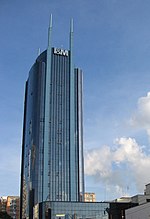University of Nairobi
The University of Nairobi (uonbi or UoN; Swahili: Chuo Kikuu cha Nairobi) is a collegiate research university based in Nairobi. It is the largest university in Kenya. Although its history as an educational institution dates back to 1956, it did not become an independent university until 1970. During that year, the University of East Africa was split into three independent universities: Makerere University in Uganda, the University of Dar es Salaam in Tanzania, and the University of Nairobi in Kenya. During the 2011 academic year, the university had 61,912 students, of whom 49,488 were undergraduates and 12,424 postgraduates. The university launched several policy frameworks and introduced self-funded enrollment (also called 'module 2') to cope with the rising demand for higher education in Kenya.As of 2022, University of Nairobi reported that it had more than 84,000 enrolled students.
Excerpt from the Wikipedia article University of Nairobi (License: CC BY-SA 3.0, Authors).University of Nairobi
Nairobi Expressway, Nairobi Chiromo
Geographical coordinates (GPS) Address Nearby Places Show on map
Geographical coordinates (GPS)
| Latitude | Longitude |
|---|---|
| N -1.2797222222222 ° | E 36.816666666667 ° |
Address
University of Nairobi (Main Campus)
Nairobi Expressway
46464 Nairobi, Chiromo
Nairobi County, Kenya
Open on Google Maps








